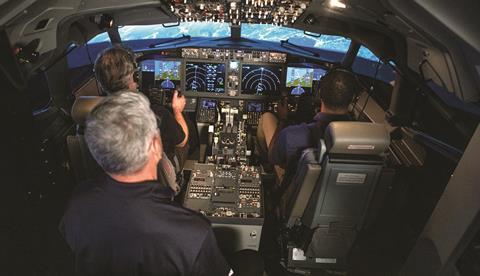FlightSafety’s philosophy goes beyond training pilots to be competent and comfortable. It challenges aviators to be equipped to deal with every possible curve ball
Aviation safety regulations are intended to ensure pilots are ready to deal with any eventuality that might endanger their aircraft and their passengers. Or at least you might think that would be the case. While the intention of statutory training requirements is to make pilots proficient, how well do these guidelines equip them to deal with untoward situations, especially those they have never encountered while flying or in the simulator?

Most pilots will go through their professional lives without finding themselves in a life-threatening situation. Today’s commercial and business aircraft – their cockpits, which are almost unrecognizable from those of a generation ago – rarely go wrong mechanically and are packed with sophisticated avionics and aids to make flying simpler and provide ample hazard warnings, from approaching terrain to the proximity of other aircraft.
Safety-minded aviators
Advances in flightdecks have undoubtedly made flying safer, but they can also breed complacency. While pilots may satisfy all regulatory requirements for knowing what to do in a range of scenarios, they will tend to believe that the machine will always work and is behaving in the way it should. Trust in his or her equipment, of course, is no bad thing for a pilot, but there are times when they need to draw on skills beyond what they have proved they can do in standard simulator sessions.
“We develop scenarios in the simulator that prepare pilots for realworld potentials”
Richard Meikle, executive vice-president operations and safety, FlightSafety
A tragic case in point is Air France 447 in 2009, where training failed to equip pilots to understand their predicament. The Airbus A330 began to stall over the South Atlantic after the pilots received inconsistent airspeed indications because of blocked pitot tubes. At the time, the aircraft was flyable – their training ensured the pilots knew how to recover from a stall. The problem was they did not think they were in a stall because they believed the flight computers would not allow this to happen.
The fact is that out-of-the-blue events occur in aviation, and often the crew does not have the expertise to spot warning signs or the tools to work out an evasive plan. That is where FlightSafety comes in. Its whole ethos is not about giving pilots the ability to pass regulatory tests, but moulding safety-minded aviators able to cope with anything their extensive cockpit career might throw at them, including both knowing how to prevent as well as recover from hazardous situations.
Unforeseen circumstances
“We develop scenarios in the simulator that prepare pilots for real-world potentials,” explains Richard Meikle, FlightSafety International’s executive vice-president operations and safety. “What we are doing is preparing someone rather than just making them proficient, such as knowing how to land the airplane with no airspeed. It might be a one in a million or more case, but when it happens it won’t be the first time you have run into it, and knowing what to do will keep you alive.”
Modern simulators, such as those built and operated by FlightSafety, with their lifelike motion and high- resolution visuals, are so realistic that pilots can train for a range of events that they could not in an actual aircraft. The idea is that pilots will build up an experience bank that allows them to react effectively to whatever they encounter. “They may not have seen the exact scenario,” says Meikle. “But they will have been shown something very similar, and response patterns become familiar.”
Another technology that is helping FlightSafety fine-tune its syllabus when it comes to dealing with these black swan moments is data analytics. No training programme can prepare pilots for every theoretical eventuality, so as part of its partnership with GE Digital, the company has been studying data on loss of control – precisely what manoeuvres and behaviours in the simulator occur in the run-up to loss of control incidents.
“Our work with GE Digital has given us lots of additional insights into loss of control and how close people are getting,” says Meikle. “This means we can identify the danger signs. Pilots are trained to react in loss of control situation, but knowing how to avoid an upset is always better than having to execute a recovery.”











































